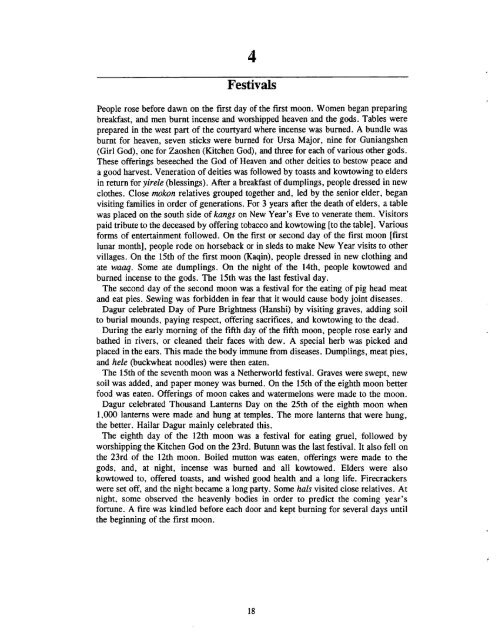China's Dagur Minority - Sino-Platonic Papers
China's Dagur Minority - Sino-Platonic Papers
China's Dagur Minority - Sino-Platonic Papers
You also want an ePaper? Increase the reach of your titles
YUMPU automatically turns print PDFs into web optimized ePapers that Google loves.
-- --FestivalsPeople rose before dawn on the first day of the first moon. Women began preparingbreakfast, and men burnt incense and worshipped heaven and the gods. Tables wereprepared in the west part of the courtyard where incense was burned. A bundle wasburnt for heaven, seven sticks were burned for Ursa Major, nine for Guniangshen(Girl God), one for Zaoshen (Kitchen God), and three for each of various other gods.These offerings beseeched the God of Heaven and other deities to bestow peace anda good harvest. Veneration of deities was followed by toasts and kowtowing to eldersin return for yirele (blessings). After a breakfast of dumplings, people dressed in newclothes. Close mokon relatives grouped together and, led by the senior elder, beganvisiting families in order of generations. For 3 years after the death of elders, a tablewas placed on the south side of kangs on New Year's Eve to venerate them. Visitorspaid tribute to the deceased by offering tobacco and kowtowing [to the table]. Variousforms of entertainment followed. On the first or second day of the first moon [firstlunar month], people rode on horseback or in sleds to make New Year visits to othervillages. On the 15th of the first moon (Kaqin), people dressed in new clothing andate waaq. Some ate dumplings. On the night of the 14th, people kowtowed andburned incense to the gods. The 15th was the last festival day.The second day of the second moon was a festival for the eating of pig head meatand eat pies. Sewing was forbidden in fear that it would cause body joint diseases.<strong>Dagur</strong> celebrated Day of Pure Brightness (Hanshi) by visiting graves, adding soilto burial mounds, paying respect, offering sacrifices, and kowtowing to the dead.During the early morning of the fifth day of the fifth moon, people rose early andbathed in rivers, or cleaned their faces with dew. A special herb was picked andplaced in the ears. This made the body immune from diseases. Dumplings, meat pies,and hele (buckwheat noodles) were then eaten.The 15th of the seventh moon was a Netherworld festival. Graves were swept, newsoil was added, and paper money was burned. On the 15th of the eighth moon betterfood was eaten. Offerings of moon cakes and watermelons were made to the moon.<strong>Dagur</strong> celebrated Thousand Lanterns Day on the 25th of the eighth moon when1,000 lanterns were made and hung at temples. The more lanterns that were hung,the better. Hailar <strong>Dagur</strong> mainly celebrated this.The eighth day of the 12th moon was a festival for eating gruel, followed byworshipping the Kitchen God on the 23rd. Butunn was the last festival. It also fell onthe 23rd of the 12th moon. Boiled mutton was eaten, offerings were made to thegods, and, at night, incense was burned and all kowtowed. Elders were alsokowtowed to, offered toasts, and wished good health and a long life. Firecrackerswere set off, and the night became a long party. Some hals visited close relatives. Atnight, some observed the heavenly bodies in order to predict the coming year'sfortune. A fire was kindled before each door and kept burning for several days untilthe beginning of the first moon.
















